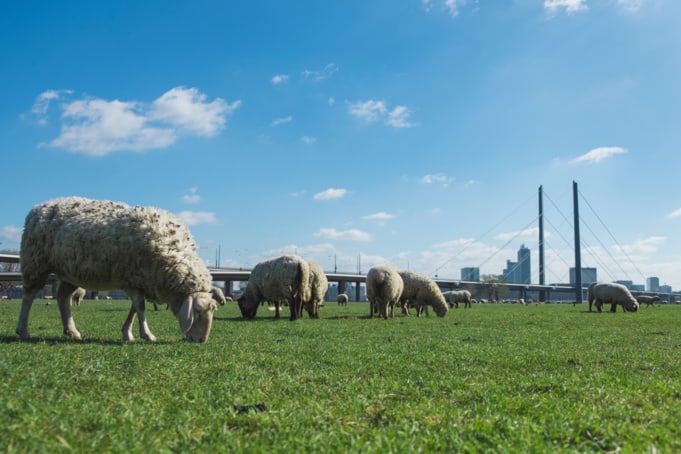
Eco-grazing in the city, a practice that appeals to communities and social housing providers
4 minutes of reading
The end of pesticides in public parks. Since 1 January 2017, in application of the law on energy transition for green growth, local authorities may no longer use plant protection products to maintain parks, roadsides or forests.

This “zero plant protection product” rule forces communities to rethink their public land management methods. Although some local authorities opt for the use of substitute products (products authorised for organic farming, biostimulants, etc.), others experiment with another type of practice: eco-grazing.
This ancestral practice consists of grazing animals in order to maintain natural spaces, and has many virtues. What’s more pleasant for city dwellers in search of nature than to come across rams, sheep and goats during a walk? Several cities have understood the benefits and are planning educational and social mediation actions based on the presence of these animals: promoting living together, creating employment opportunities to take care of the animals, knowledge of nature and animals, etc.
The issue is also ecological since the use of eco-grazing for the maintenance of green spaces contributes to the preservation of biodiversity, the promotion of less common or threatened older breeds, and the reduction of environmental impacts (zero treatments, natural fertilisers, zero noise, etc.).
 The practice appeals to other players too. In the region of Dieppe, in Seine-Maritime, the Sodineuf Habitat Normand social housing provider has started to implement a large-scale eco-grazing project. In collaboration with Ökotop, an association specialising in eco-responsible management of green spaces, it has identified 5 hectares spread over 13 sites that can be maintained by livestock. Around 60 sheep and goats are grazing there within the social housing provider’s property. Actions around animals (raising awareness, shearing, etc.) are planned with residents, in partnership with associations in the district.
It’s a way of arousing the residents’ curiosity and contributing to the development of nature in the city.
The practice appeals to other players too. In the region of Dieppe, in Seine-Maritime, the Sodineuf Habitat Normand social housing provider has started to implement a large-scale eco-grazing project. In collaboration with Ökotop, an association specialising in eco-responsible management of green spaces, it has identified 5 hectares spread over 13 sites that can be maintained by livestock. Around 60 sheep and goats are grazing there within the social housing provider’s property. Actions around animals (raising awareness, shearing, etc.) are planned with residents, in partnership with associations in the district.
It’s a way of arousing the residents’ curiosity and contributing to the development of nature in the city.
 The practice appeals to other players too. In the region of Dieppe, in Seine-Maritime, the Sodineuf Habitat Normand social housing provider has started to implement a large-scale eco-grazing project. In collaboration with Ökotop, an association specialising in eco-responsible management of green spaces, it has identified 5 hectares spread over 13 sites that can be maintained by livestock. Around 60 sheep and goats are grazing there within the social housing provider’s property. Actions around animals (raising awareness, shearing, etc.) are planned with residents, in partnership with associations in the district.
It’s a way of arousing the residents’ curiosity and contributing to the development of nature in the city.
The practice appeals to other players too. In the region of Dieppe, in Seine-Maritime, the Sodineuf Habitat Normand social housing provider has started to implement a large-scale eco-grazing project. In collaboration with Ökotop, an association specialising in eco-responsible management of green spaces, it has identified 5 hectares spread over 13 sites that can be maintained by livestock. Around 60 sheep and goats are grazing there within the social housing provider’s property. Actions around animals (raising awareness, shearing, etc.) are planned with residents, in partnership with associations in the district.
It’s a way of arousing the residents’ curiosity and contributing to the development of nature in the city. More reading
Read also




What lies ahead? 7 megatrends and their influence on construction, real estate and urban development
Article
20 minutes of reading

